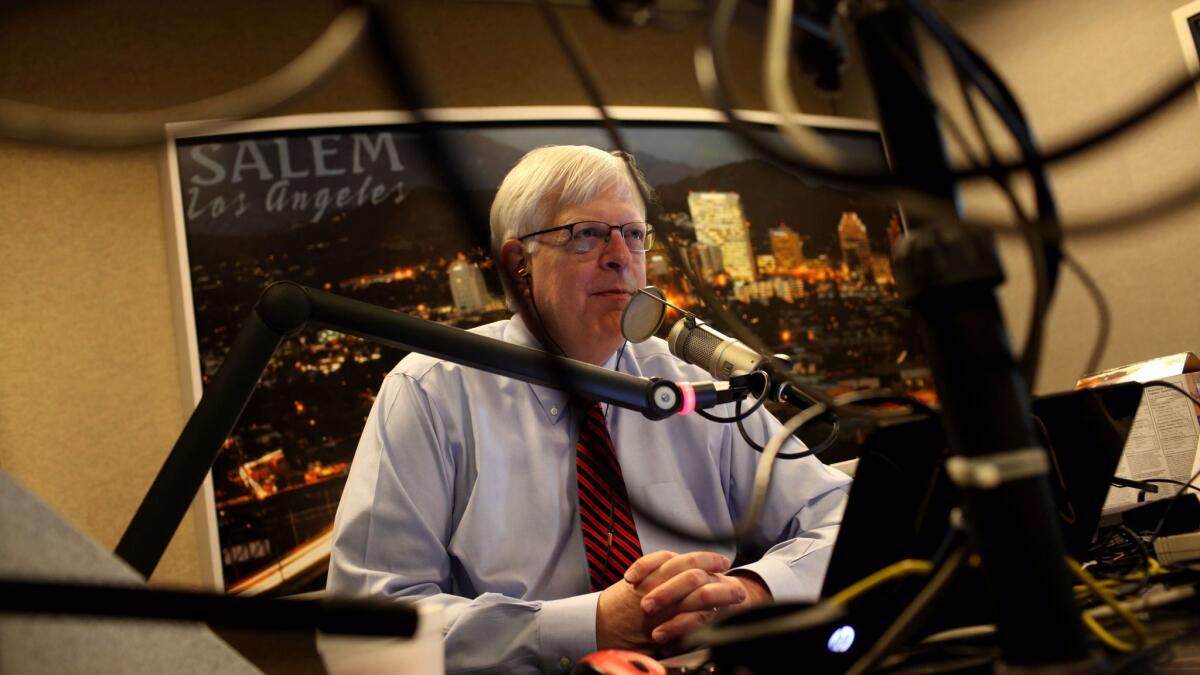Critic’s Notebook: When Dennis Prager conducts Santa Monica Symphony, there’s no avoiding politics

The Santa Monica Symphony will hold a gala in Walt Disney Concert Hall on Aug. 16, and that has caught the unlikely attention of the alt-right Breitbart News website. Welcome to culture wars, 2017 style.
With conservative radio show host Dennis Prager hosting Haydn’s Symphony No. 51, which he has been invited to conduct as part of a program otherwise led by the orchestra’s music director, Guido Lamell, two violinists are asking that fellow musicians in the orchestra and members of the audience made uncomfortable by Prager’s positions on gays, Muslims and liberals boycott the performance.
Prager’s response came in a National Review op-ed, “Can a Conservative Conduct an Orchestra?” He protests that it is no longer enough for liberals to want to prevent conservatives from speaking on campuses. Now “conservatives should not even be allowed to make music.”
Can a conservative conduct an orchestra? Yes. Next question.
Can a public conservative conduct an orchestra? Prager amended the question on his radio show Monday when challenged by Andrew Apter, one of the violinists calling for the boycott. The answer remains yes, with the understanding that political context cannot be evaded.
Can a divisive public conservative amateur musician conduct an orchestra? That’s asking for trouble.
It was not always so, but orchestras these days tend to be, in their players and administration, more liberal than conservative. Once almost exclusively white, male and Western, the institutions have become increasingly diverse in the last half-century.
There may still be conservative-leaning players, but the orchestra ideal is everyone working toward a common goal, and that is achieved far more successfully in music than in other aspects of modern life, including modern politics.
It is also true that most conductors are likely liberal. Just the other day, for instance, Simon Rattle told the Guardian newspaper that he would have had second thoughts about his assuming the post of music director of the London Symphony next month had Brexit already passed when he signed his contract.
But as always, there are notable exceptions. One of Germany’s most acclaimed conductors, Christian Thielemann, has defended PEGIDA, the far-right German nationalist political movement that opposes immigration.
Prager’s situation is different. Rather than being a celebrated musician, he has slender conducting credentials. A lifelong classical buff who studied piano, he states that he has taught himself to read orchestral scores (a significant skill) and that he has conducted several community orchestras in Southern California, as well as the Los Angeles Philharmonic at the Hollywood Bowl. The latter was the national anthem in 1994. Three years ago, he was host and emcee for the Glendale Symphony Christmas Music Spectacular.
Conducting requires a special combination of talents as well as a vast amount of experience. The skill to stand in front of a sea of players and pick out every note in every instrumental line in rehearsal is overwhelming. At the same time, a conductor must anticipate what comes next and signal the cues a nanosecond ahead of time. Try it sometime. All the while you have to convince seasoned players that you know more than they do.
Prager’s choice among Haydn’s 104 mature symphonies of the seldom-played No. 51 seems curious. Written in the early 1770s, it is one of the composer’s “entertainment symphonies,” which followed a period of Sturm und Drang symphonies. That movement opposed the liberal orthodoxy of the Age of Reason, with stormy passion, which you would think would be right up Prager’s alley.
But he may not want to take any chances, and his Haydn symphony doesn’t make many technical demands. It has the further advantage of — unlike Beethoven’s Fifth, with which Lamell will conclude the program — being obscure, giving Prager interpretive wiggle room.
But slight Haydn has its own pitfalls. The texture is thin, meaning individual instrumental lines are exposed, and the orchestra will be playing for the first time in the revealing Disney Hall acoustic. Balances will need to be handled with extreme care, for which even the most experienced conductor requires decent rehearsal time. (Prager can’t expect much; Disney rent is higher than even what spaces go for now in Santa Monica.)
Haydn was a wit, and he put funny things in the symphony. These include quirky syncopations in need of a nimble rhythmic touch to catch their sly humor. If the symphony is known for anything, it is the two horn parts. In a startling Haydnesque flight of fancy, the first horn sails to the top of its range in a killer passage at the start of the second movement; the second sinks to its lowest note right after. If anything goes wrong — and anything can when it comes to this unsteady instrument — the conductor must have the expert control to not let that throw the performance.
Still, when an orchestra wants to make a tyro on the podium look good, it can. Frank Zappa somehow pulled off conducting Varèse with the San Francisco Contemporary Music Players. The late Gilbert Kaplan made a fortune on Wall Street and then spent the rest of his life devoted to conducting Mahler’s Second Symphony with many of the world’s great orchestras, and he made many friends along way. With a little coaching from Gustavo Dudamel and the cheerful goodwill of the L.A. Phil, Gael García Bernal led a winning performance of Mozart’s “Marriage of Figaro” Overture at the Hollywood Bowl for an episode of “Mozart in the Jungle.”
In this case, though, the Santa Monica Symphony has been put in a terrible predicament. The fundraising nature of the concert is important to the orchestra, which means not puffing up Prager might be self-destructive. Plus, he is someone who uses his popularity to promote classical music. Prager’s militant polarizing of issues (say, calling liberalism a cancer) ensures that the audience will likely be sizable and one-sided.
Ultimately, then, the orchestra is being asked to enhance the stature of someone whose prominence is based on espousing an ideology that disapproves of who many of the players are and what they stand for. Let’s not forget the extra-musical advantage that Prager, who actively sells his brand with PragerU and books and his radio show, has to gain.
However the concert turns out, which will probably be less than a disaster, Prager is in a position to do as much harm as good for the orchestra. He may have enough fundraising muscle to make the concert a success, but in the process he taints the Santa Monica Symphony with a seeming political bias once it returns home. What with the city’s current frenzy for development, it is no longer the People’s Republic of Santa Monica. But it is hardly Prager country. That is a high price to pay for a celebrity non-conductor.
MORE FROM OUR CRITICS:
Review: Vasily Petrenko at the Hollywood Bowl
‘Meth and modernism’: The understated ‘Columbus’ and small-town America
2017 California-Pacific Triennial at OCMA: The art of building up (and tearing down)
More to Read
The biggest entertainment stories
Get our big stories about Hollywood, film, television, music, arts, culture and more right in your inbox as soon as they publish.
You may occasionally receive promotional content from the Los Angeles Times.











